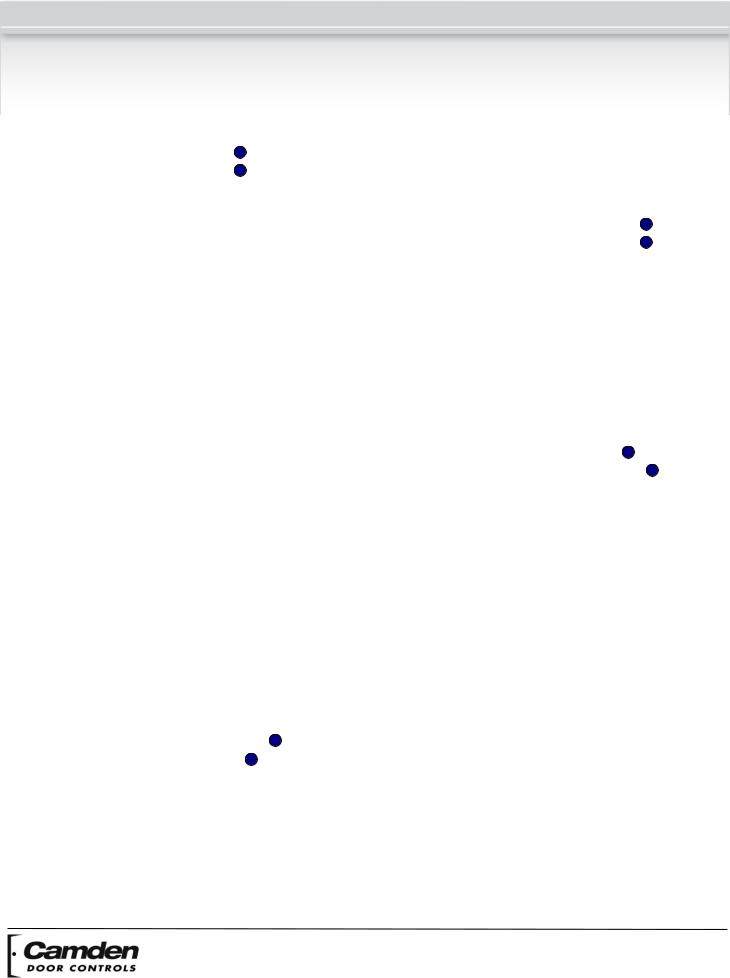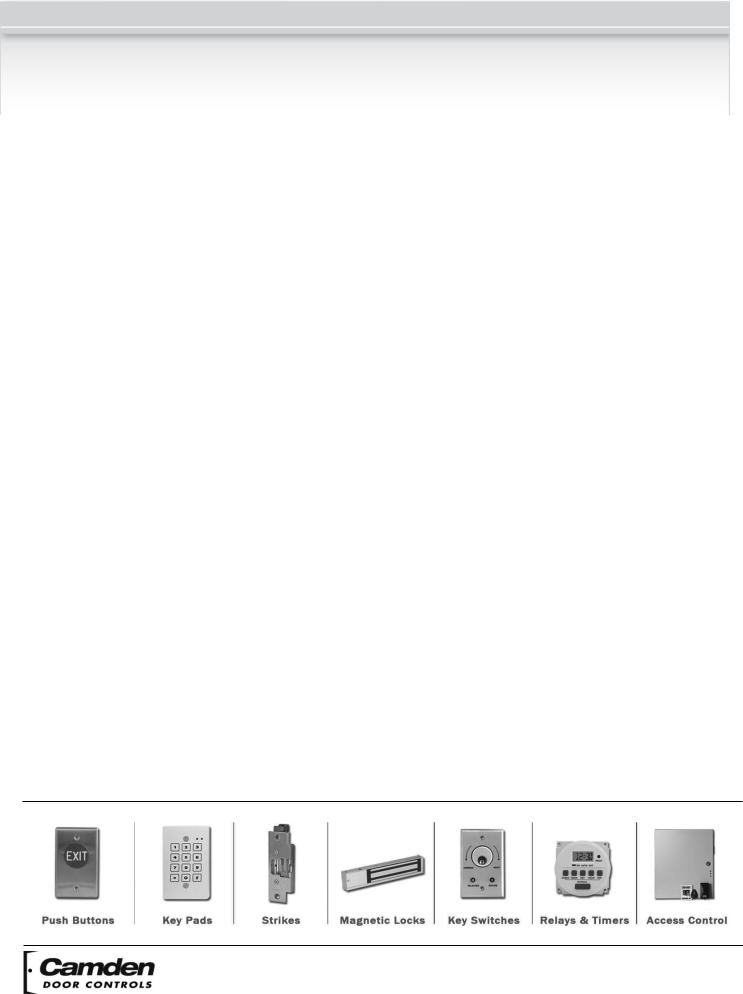Camden Door Controls CX-12 User Manual

Section 1__________________
General Description
The CX-12 is the latest generation multi-purpose timer. It is designed to be versatile yet user friendly with easy to understand terminology and adjustments. (It supersedes Model CX-11 Ultra)
Used as a make/break relay (or Switching Network) it eliminates the binding of locked automatic doors, by delaying the door operator until the strike or electromagnet (de) activates first.
A new feature of this model is the ability to select one of 4 Modes of operation – momentary; maintained with Relay 1 held; maintained with Relay 2 held; and bi-directional door sequencing (SEE DIAGRAM 04).
In the Momentary position, even a stuck switch input will allow the door to time out and close, thereby providing security to occupants. The CX-12 will however, still operate normally if one of the other inputs is activated. Essentially, it ignores the faulty activation source, as all inputs are isolated.
The inputs to the CX-12 may be either dry or wet (powered), meaning that 3-terminal radio receivers may be connected directly to the CX-12 without fear of malfunction. SEE DIAGRAM 01.
Additionally, we provide a direct connection from an apartment interphone panel. Only Relay #1 (strike) will operate when a voltage is applied to this input. A vestibule courtesy switch will be energized for the time set by Pot. 1. SEE DIAGRAM 03 a or b.
Select Relay 1 Maintained for an Access Control application. When a maintained signal is applied to WET 1 input, the lock will remain energized, while the DRY 2 input allows a wall switch to open the door. An input on DRY 1 will always unlock and open the door.
SEE DIAGRAM 02b.
Select Relay 2 Maintained if you are connecting the CX-12 to a fire alarm panel, or to a presence sensor. In this mode the lock will fire momentarily but the operator relay will be held in as long as the input is maintained. SEE DIAGRAM 02a.
CX-12 Switching Network
& Bi-Directional Door Sequencer
Installation Instructions
For latching (ratchet or alternate action) functions, we recommend our Model CX-1000/78 multi-purpose timer, or Model SA-1 Switching Network.
IMPORTANT: Do not apply power to the unit until you have read the instructions fully and made the required adjustments.
Section 2__________________
Installation
Mounting
The LED’s are visible through the wrap-around sleeve, which also has cutouts for adjusting the potentiometers, and setting the dip-switch. Once the unit has been adjusted, it may be tucked up into the operator header or affixed using the supplied Velcro.
Wiring
Wiring of this unit is dependent on the mode desired, however the following commonalities apply.
Note: Do not wire Safety devices to the CX-12. If installed, wire your safety device directly to the operator control box as per usual.
CAUTION: Do not apply power to the unit until all secondary wiring is complete, and dip-switches have been set.
Both relay outputs are Form C and are rated at 3 amps maximum. Use relay # 1 for the strike or electromagnet. Generally the N.O. & COM. terminals (#3 & 4) are used for a strike, and COM & N.C. (#4 & 5) are used with an electromagnet.
The door operator will be wired to relay #2 N.O. & COM terminals (#6 & 7). In a door sequencing application, door 1 is relay #1, and door 2 is relay #2.
The unit will operate on 12 or 24 volts, AC or DC. Connect to Terminals 1 & 2, which are non-polarity sensitive.
Page 1 of 10

CX-12 Switching Network & Bi-Directional Door Sequencer Installation Instructions
APPLICATIONS
& SET-UP INSTRUCTIONS: STANDARD TIMER MODE
Set dipswitches as shown > |
|
Off / On |
|
1 |
|
|
|
|
|
||
|
|
|
|
Refer also to Diagram 01. |
2 |
|
|
|
|
|
|
Connect a dry contact such as a wall switch to DRY1 (Terminals 11 & 12). A Wet (powered) output connects to WET 2 (Terminals 13 & 14).
Upon a switch activation the strike relay will fire for the time set by potentiometer 1 (DOR RL1). After a delay, adjustable by potentiometer 2 (DOO RL2), the operator relay will fire. The hold time for relay #2 is set with potentiometer 2 (DOR RL2).
Most modern door operators have built-in time delays, and if so, it is usually desirable to use them to add sufficient hold-open time. In this case adjust the CX-12 to send just a momentary pulse (1 or 2 seconds only).
Observe the door and adjust timers until desired operation is observed.
The above dipswitch setting is also used for applications such as apartment entries with an interphone panel. Refer to Diagrams 03a & 03b.
In each case the interphone input (WET 1) will activate the strike relay only. If a courtesy switch is located in the vestibule, it is connected to DRY 2 (Terminals 15 & 16). This input is only active when the strike relay is energized.
Another application using this mode is door sequencing in one direction only. Connect Door 1 operator to relay 1, and door 2 operator to relay 2. The delay between the two doors is adjusted via the DOO RL2 potentiometer. For bi-directional sequencing refer to specific set-up instructions below.
EXTENDED TRIGGER MODE – RELAY 1
Off / On
Set dipswitches as shown > |
1 |
|
|
Refer also to Diagram 02b. |
2 |
|
|
|
|
|
Typically the access panel (or time clock) will be wet (powered) therefore connect to WET 1 (Terminals 9 &10).
The exterior activating switch is wired to DRY 2 (Terminals 15 & 16). This input signals the door operator (Relay 2), and is only active when the strike relay is energized.
An interior switch may be connected to DRY 1 (Terminals 11 & 12). This input will always unlock and open the door when activated. (Regardless of the status of input connected to WET 1).
If the interior switch is Wet (powered) connect to WET 2 (Terminals 13 & 14).
EXTENDED TRIGGER MODE – RELAY 2
Off / On
Set dipswitches as shown > |
1 |
|
|
Refer to Diagram 02a. |
2 |
|
|
|
|
|
|
|
|
|
Suitable for connection to a Fire Alarm Panel, this mode will fire the electric lock momentarily, then hold in the operator relay until the input is released.
Connect the Wet (powered) output of the Fire panel to WET 2 (Terminals 13 & 14)
A device with a dry output such as a Presence sensor will connect to DRY 1 (Terminals 13 & 14).
Bi-Directional Sequencing MODE
Off / On
Set dipswitches as shown > |
1 |
|
|
Refer to Diagram 04. |
2 |
|
|
|
|
|
|
|
|
|
Turn on power and activate the Interior input (switch). Observe LED1, which should light immediately. The length of hold time is determined by adjusting the pot marked DOR/RL1, clockwise for more time, counter clockwise for less time.
The delay between the two doors is adjusted via the DOO RL2 potentiometer.
After the above-mentioned delay, LED2 should light. The length of hold time is adjusted by the pot marked DOR/RL2.
The ideal time delay between the two doors is best set by actual walk-testing. It should be set so that a person can walk in either direction without having to pause before the second door activates. Test in both directions.
If an emergency (or anti-entrapment) switch is desired in the vestibule, then wire that switch directly to one of the operator inputs. Usually the exterior door is used in this case.
Once the desired operation is achieved, proceed to Section 4, for System Inspection Instructions.
Page 2 of 10
5502 Timberlea Blvd., |
www.camdencontrols.com |
Mississauga, ON Canada L4W 2T7 |
Toll Free: 1.877.226.3369 |
File: CX-12_NF_Rev1.doc
Revised: 13 January 2010
Part No.: 40-82B103

CX-12 Switching Network & Bi-Directional Door Sequencer Installation Instructions
Section 4 _________________
System Inspection Instructions
After the Installation and operational check of the system:
1.Place warning label on the door (as per ANSI A156.10 or A156.19 guidelines). This will advise the person entering the swing side zone that the door will move.
2.Instruct the owner on door system operation and how to test it. This should be checked on a daily basis.
3.Instruct the owner on what to do if the door or any of its components become damaged.
4.Strongly recommend to the owner that the complete entry be inspected twice a year as part of the service agreement.
Section 6_________________
Warranty
Section 5_________________
Technical Data
Model |
CX-12 |
Size |
3 ¼” x 2 ¼” x ¾” |
Mounting |
Velcro or double-sided tape |
Enclosure |
Protective paper sleeve. |
Operating voltage |
12 / 24 Volts, AC / DC |
Current Draw |
18 mA standby, |
|
40 mA max. |
Response time |
0.3 seconds |
Inputs |
2 x “dry” contacts, |
|
2 x “wet” contacts: |
|
(3-30 V AC/DC, Optically |
|
isolated, non-polarity |
|
sensitive). |
Relay Output |
2 x Form C (SPDT) |
Relay contact rating |
3 amps @ 20 VDC |
Time Delays |
DOR #1 1 to 30 seconds |
|
DOO # 2 1 to 30 seconds |
|
DOR #2 1 to 30 seconds |
Electrical Life |
100,000 operations |
|
@ rated capacity |
|
500,000 operations |
|
@ ½ rated capacity |
Camden Door Controls guarantees the CX-12 to be free from manufacturing defects for 3 years from date of sale. If during the first 3 years the CX-12 fails to perform correctly, it may be returned to our factory where it will be repaired or replaced (at our discretion) without charge. Except as stated herein, Camden extends no warranties expressed or implied regarding function, performance or service.
Questions?
Call us toll-free at 1-877-226-3369
Page 3 of 10
5502 Timberlea Blvd., |
www.camdencontrols.com |
Mississauga, ON Canada L4W 2T7 |
Toll Free: 1.877.226.3369 |
File: CX-12_NF_Rev1.doc
Revised: 13 January 2010
Part No.: 40-82B103
